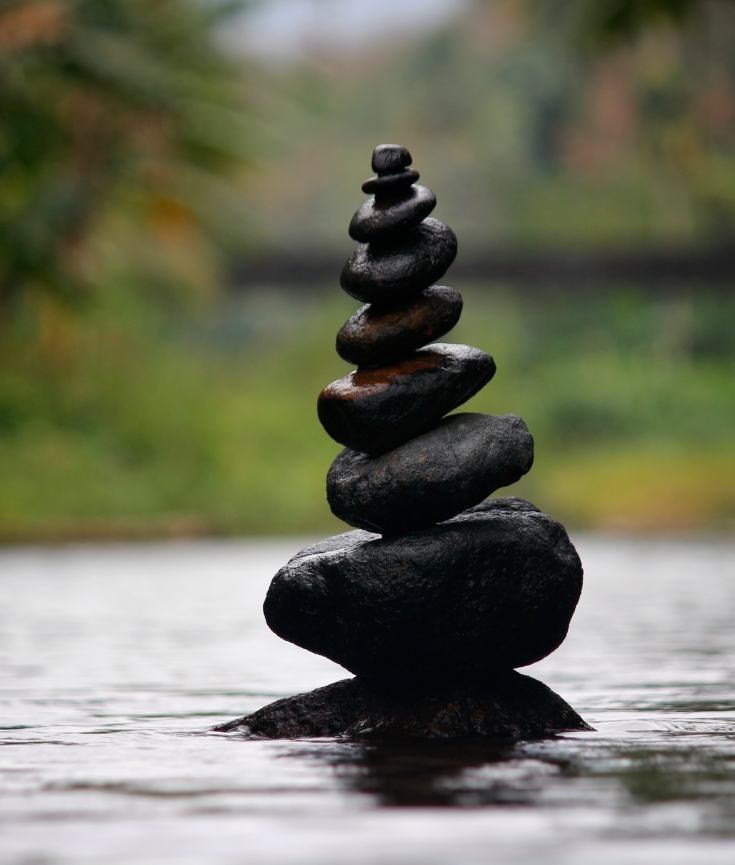Mindfulness has become a trend in the self-care industry. This is probably because it’s such a simple, easy way to improve your day-to-day life. I was first introduced to this practice when I started counseling sessions during my freshman year of college. My counselor, Angela Weixel, is a mindfulness expert and explained that this method is a unique way to deal with my depression and anxiety. Back then, I’ll admit, I didn’t really pay attention to what she was saying. Not because I thought she was wrong, but because I couldn’t see myself benefiting from this. Mindfulness focuses on relaxation and getting in touch with your energy, which, at the time, I thought my restless mind could not handle.
What is Mindfulness?
Another reason I never gave mindfulness a chance was because I didn’t really understand it initially and wanted to learn more. I feel like many people are in the same boat as me and defining this practice will be helpful for those who are interested. After doing some research, I found a definition that, I believe, encompasses the variety of definitions:
“Mindfulness is the basic human ability to be fully present, aware of where we are and what we are doing, and not overly reactive or overwhelmed by what’s going on around us.”
This is a general definition for people learning about mindfulness for the very first time. Once you start participating in these (mental) exercises, however, you begin to see that mindfulness is a subjective process. It’s all about YOU. It’s about your emotional, mental and physical state. This idea of “self-help” is what made me, and probably many others, hesitate before practicing mindfulness. With my anxiety, depression, stress, etc., how can I successfully learn how to take care of myself? Before I answer this question, I need to answer the question that everyone asks:
Why Should I Practice Mindfulness?
As you may have noticed, I am a very skeptical person. When I was doing my research, I was able to find some evidence to back up the benefits of mindfulness.
Here are a few general reasons why people should practice mindfulness:
- It helps you understand your pain (mental and physical).
- You connect with people better.
- It decreases stress.
- It helps you focus.
- It reduces your brain’s overwhelming thinking.
For the science-lovers, here’s a list of research-based evidence:
- Studies show that mindfulness boosts our immune system.
- It acts as a stress reliever and an “antidepressant.”
- It changes our brains by increasing the density of gray matter, which is linked to areas of learning, memory, emotion, and empathy.
To view the full list and links to the studies, visit http://greatergood.berkeley.edu/topic/mindfulness/definition.
So, with all of this said, let’s see how I began my journey to mindfulness.
Mindfulness Apps and What I Thought
I decided I would initially practice mindfulness through some cell phone apps that people/the Internet suggested to me. Yes, mindfulness is kind of supposed to detatch you from material objects and probably your iPhone, this is a nice way to begin into the process when you don’t have a guide. This, to me, is an easy way for people to ease into this these exercises. Here is a list of apps and what I thought of them:
- The Mindfulness Training App
Starting with this app was a little discouraging…because I didn’t like it at all.To me, mindfulness represents peace and relaxation. This app looked veryrobotic and did not fit my screen correctly. Not only did it look weird, but it also was incredibly unorganized, and not user friendly. The different sessions that it offered were not easy to navigate and weren’t even in order. I am specifically talking about the “What is mindfulness?” session listed as the second audio program…After (finally) finding the beginners session, I started listening to the audio and the guy’s voice was a little, how do I put this nicely…creepy? All in all, this app was confusing and did not give off a good “mindfulness” vibe.
- Calm
This app was more promising than the previous. The woman’s voice wasn’t creepy, it was much more pleasing to look at, and it was well organized. The homepage has a simple background that corresponds with your choice of sound. For example, if you choose mountain-lake, you will have a screen saver of a mountain with the sound of water. I chose the sound “fireplace,” which came with a crackling fire in the back. While this app was really organized and many different options for how to individualize your practice, the background noise started to get annoying. You, of course, have the option to turn off the sound, but, for me, trying to navigate the app and then trying to find the sound settings ended up driving me crazy and I closed the app. One thing I learned about mindfulness is that you need to have a lot of patience, which is something I am trying to get better at…but an annoying app does not help.
- Headspace
A lot of people suggested this app to me, so I made sure to explore it very thoroughly. However, this was kind of difficult with all of the obstacles that this app presented. First of all, each series has to be unlocked. So, I didn’t really have the option to explore the app. Also, you have to PAY to unlock anything besides the first session. This was kind of a buzzkill since I’m a broke college student and all. Anyways, I went ahead and tried the first session. This started with a one minute animated video explaining what mindfulness is. This was pretty helpful and the dude had a British accent so that’s a plus. The following 10 minute session was very relaxing and gave me a taste of what mindfulness entails, but I was expecting more.
- Stop, Breathe & Think
This app is AMAZING. Finally, right? Anyways, it’s aesthetically pleasing, user-
friendly and, most importantly, it makes mindfulness more attainable to a doubter like me. This app teaches you how to meditate, explore different activities like breathing, yoga, and healing (just to name a few), and it keeps track of your progress. I was finally able to start my journey to mindfulness and I want to give you an example of how I, a disbeliever, finally want to practice mindfulness. One exercise in this app involves assessing how you are feeling on a particular day and participating in exercises that they suggest to you. One of the options I had was to do a “Mindful Walk.” This, to me, is perfect for college students who have long walks to class. It only takes about 10 minutes and it focuses on the mindfulness of being aware. When I did this mindful walk, I was instructed to focus on my five senses internally and externally. It focused on NOT thinking about anything but what they instruct you to think about. This may sound weird but IT WORKS. My anxiety (you know, the feeling that an elephant is stepping on your chest) instantly went away and I stopped thinking about exams, homework, etc. I was most surprised by how quickly it worked. But if you don’t believe me, check it out for yourself!
Mindfulness with an Expert
After I tried mindfulness on my own, I decided to visit my counselor, Angela Weixel. Angela has been certified in the mindfulness field for about 5 years, specifically in dance mindfulness. I interviewed her on the topic of mindfulness and asked questions that I thought most beginners might ask:
How long have you been practicing mindfulness?
I am certified in dancing mindfulness. I started studying it after I graduated in 2014, however, I believe I have been practicing since 2012.
What is your definition of mindfulness?
Mindfulness means being in the present moment without judgement yourself, the situation, or others.
How do you think mindfulness helps people?
Mindfulness fosters greater acceptance for yourself, thoughts, and the way you interact with the world. You have trouble empowering yourself when you are the victim. With mindfulness, you step out of the victim mode and you become the observer, which allows you to have new perspective. This is a great way to help those with anxiety.
Do you have any advice for people trying to practice mindfulness?
Be patient and practice, it’s one of those things that’s easier said than done. And get creative by doing something like mindful dish-washing or other necessary chores. Something as simples as naming 5 things in a room allows you to be IN that room. For beginners, really pay attention to the five elements; sight, taste, touch, smell, hear. When speaking to patients, I make sure to tell them that they DO NOT need to focus so much on clearing their mind and sitting perfectly still – it’s about coming back to awareness. You aren’t doing a bad job if you have thoughts, you’re doing a good job if you realize you have thoughts. Don’t judge yourself; observing that you have thoughts is being mindful.
What do you have to say to people who don’t “believe” in it?
That’s an interesting topic because mindfulness can become bigger and bigger the more you talk about it. I would hold space for those people because I can’t judge them for not being ready – it isn’t for everybody.
Any final comments?
Mindfulness is important for our western culture because we have a dualistic mindset – good or bad. Eastern philosophy believes in just being, not being good or bad; self-worth is derived from just living your life. Mindfulness can be very simple or it can be completely life-changing.
My Conclusion
I embarked on this journey to mindfulness to help me (and you guys) understand what this practice is all about. Mindfulness is a very individualized way to help improve our lives, which is why it is important to define it for yourself. After all of the research, the app testing, and the interview with an expert, I have finally come up with MY definition of mindfulness: “Mindfulness means to stop focusing on the past or the future, and to start focusing on today.” In other words, stop worrying about any mistakes you have made, stop being anxious about your future, and start focusing on the present moment – whether that’s dish-washing or appreciating time with a friend.

